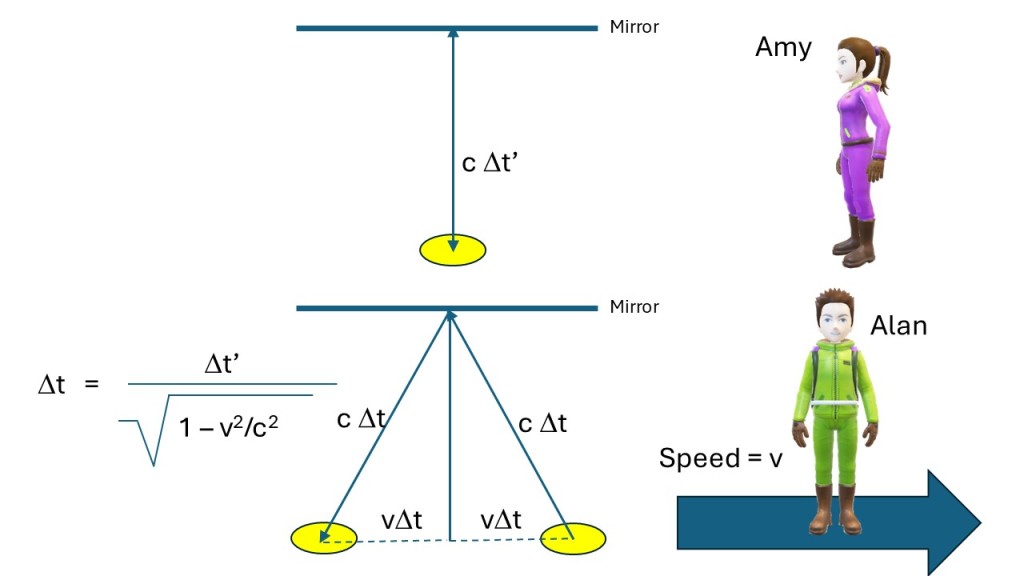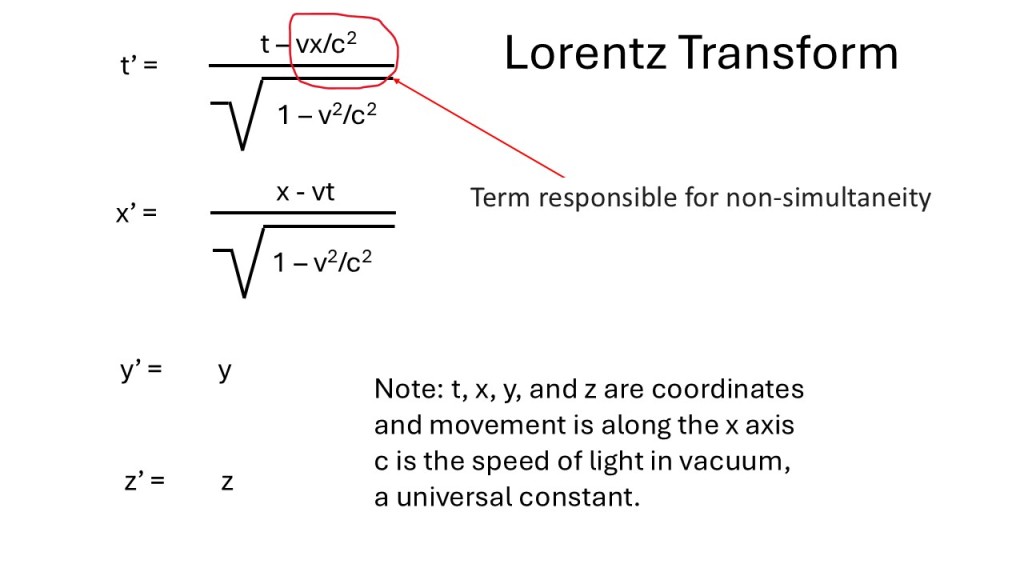Superfact 5 : Two events may be simultaneous for some but not for others
Two events may be simultaneous for some but not for others. This means that two events that are simultaneous to an observer may happen at different times to other observers. If two lamps A and B turn on at the same time according to observer #1, lamp A may turn on first for observer #2, and lamp B may turn on first for observer #3. All three observers are correct because time is relative.
Previous Fact:
My previous blog post “The Speed of Light In Vacuum Is a Universal Constant” explained that the speed of light in vacuum compared to yourself is the same regardless of your motion or the origin of the light beam. A beam from a flashlight you are holding is traveling at a specific speed c = 299,792,458 meters per second as compared to you. If your friend is traveling at half the speed of light compared to you, he will still agree that the light beam from your flashlight is traveling at the specific speed c = 299,792,458 meters per second as compared to him, just like his own light beam by the way.
No matter how everyone is traveling everyone agrees that all light beams everywhere, emanating from everyone’s flashlights, all travel at exactly the same speed c = 299,792,458 meters per second. Like I said, the speed of light in vacuum is a universal constant. This is made possible by accepting that space and time are relative, but what does that mean? As mentioned in the other post this leads to the special theory of relativity.
I can add that since we are talking about relativity, or rather special relativity, relativistic effects have been very well tested by thousands of experiments and are not in doubt by the scientific community. Don’t be fooled by the word “theory” in special theory of relativity. “Theory” is not used the same way in science as in everyday language.

Relativity of simultaneity
Time is relative not only means that clocks are running slower in moving systems or that distances are contracted. It means that observers will disagree on how fast clocks are running and even disagree on whether events are simultaneous or not and in which order events occur.
If you are traveling through space at a very high speed and your wife/husband is back on earth, you can’t really ask yourself, “I wonder what my wife/husband is doing now?”, because what time it is back on earth depends on how it is calculated and by which observer. There is no universal now. Time is not absolute. Time is relative. The speed of light in vacuum is what is absolute.
I should add that if you combine space and time into spacetime you get an entity that is the same for all observers, the spacetime interval. You can say that in four dimensions the relativity disappears, but that is beyond the scope of this blog post.

Below I am going to explain what is going on in more detail. If you don’t want to get into the details you can stop reading here. I am not going to explain the theory of special relativity, but I will explain some of the background and it gets a little bit complicated. Explaining scientific theories is not the goal of this blog. The goal of this blog is to list scientifically/expert accepted facts that are still disputed amongst the public or are highly surprising facts. Let’s look at time dilation first.
Time dilation
That clocks run at different speeds as a result of the constancy of speed of light in vacuum is pretty much well accepted. This is called time dilation. If Amy is passing Alan at a high speed, Alan will see Amy’s clocks running slower than his. This can be illustrated by the light clocks depicted below. The light clocks consist of light beams that are bouncing up and down between the floor and a mirror in the ceiling. Since light in vacuum is a universal constant, this is a very precise and reliable clock.
However, from Alan’s perspective the light beam in Amy’s system/spaceship must go farther than in Alan’s system (but note, from Amy’s perspective it is the opposite). Since the speed of all light beams in vacuum is a universal constant Amy’s clock is slower from Alan’s perspective.

When you realize that speeds and velocities are relative, a difficulty arises, perhaps even an apparent paradox. Let’s assume that you are flying in a rocket in space, and you meet another rocket, and your relative speed is 10 million miles per hour.
Is the other rocket standing still and you are moving at 10 million miles per hour? Is the other rocket moving towards you at 10 million miles per hour and you are one standing still? Or are both moving at the speed of 5 million per hour towards each other? Who gets to decide? Do we decide what is “standing-still” by tying it to a point on the surface of planet Earth, the center of planet Earth, the center of our solar system, or the center of our galaxy, or maybe another galaxy or an ether that no one can find?
The point is velocities are always compared to something and can be assigned arbitrary numbers. That means that if an observer, Amy, is speeding past another observer, Alan, at a high speed, then Alan thinks that Amy’s clock runs slower, but note, speed is relative, so we can reverse the situation. In fact, Amy thinks that it is Alan’s clock that runs slower.

To understand how this works and why this is not a contradiction you need the Lorentz transform. The Lorentz transform is a so-called coordinate transform that incorporates time and space (as variable x), and it determines the specific time and space coordinate for one system based on the time and space coordinate for another and the relative velocity between the two. The Lorentz transform is a way of keeping account of time and space coordinates and using it correctly resolves any apparent paradoxes.
It is a bit more complicated to derive the Lorentz transform, and it is beyond the scope of this blog post. Suffice it to say that it is the vx/c2 term in the equation that both explains how it is possible for both Amy and Alan to consider the other’s clock slower and introduces the non-simultaneity aspect of special relativity. You have to look at both space and time to get the full picture.

The Twin Paradox
There is one obvious paradox that I need to address. Let’s say that Amy and Alan are of the same age. Then Amy leaves earth and travels at high speeds toward the star Sirius. From Alan’s perspective Amy’s clocks are running slower and from Amy’s perspective Alan’s clocks are running slower.
What will happen if Amy turns around and returns to earth after visiting Sirius and they meet up again? Will Amy be younger than Alan or will Alan be younger than Amy. Will they both be younger than each other? Well, the latter is not possible. You have to keep count of the time and what happens is that during the decelerations/accelerations necessary for Amy to turn around as well as the speed-up/slow-down around earth, Amy will catch up on the time that she lost with Alan.
In other words, her acceleration will make it so Alan’s clocks will run faster. When she comes back and meets up with Alan back on earth, Alan will be much older than her.
Recommended Reading
Below is some recommended reading on the Special Theory of Relativity.
- Relativity Visualized by Lewis Carrol Epstein This does not require much education in physics and very little math, and yet it explains relativity very well. It is written by a high school teacher.
- Relativity, The Special and the General Theory, by Albert Einstein. In my opinion, not the best overall, but it is easy reading for the general public and the chapter on the relativity of simultaneity is pretty good.
- Quantum Physics of Atoms, Molecules, Solids, Nuclei and Particles by Robert Eisberg and Robert Resnick.
- The Special Theory of Relativity by David Bohm. It is written for people with some physics education, but it is one of the best books on special relativity that I’ve read.
- Einstein’s Miraculous Year This book features the translations of the five famous papers that Albert Einstein wrote in 1905 including “On the Electrodynamics of Moving Bodies”, which was his paper on Special Relativity. Not for the faint of heart but very interesting.
Note after copying all the text from my word document to WordPress I realized that wordpress cannot handle symblic characters. Thus all my delta-t were turned into Dt. I am sorry about that.


Hi Thomas, thank you for this detailed post. I have done my best to take it all on board. I will send it to my son to read as he is very interested in this topic.
LikeLiked by 2 people
That sounds good. Thank you very much Robbie.
LikeLike
My pleasure
LikeLiked by 1 person
interesting post – you’ve done a great job breaking it down & illustrating
LikeLiked by 1 person
Thank you so much for your kind comment da-AL
LikeLiked by 1 person
So it is Amy’s acceleration back to earth that breaks the simetry. And she doesn’t ages.
LikeLiked by 1 person
Yes that is right. Her acceleration speeds up Alan’s clock to make the contradiction vanish when they meet again, and she will be the younger one. It is a bit strange.
LikeLiked by 1 person
Sci-fi material.
LikeLiked by 1 person
Yes you are right
LikeLiked by 1 person
Fascinating research and topic Thomas – even though my brain is not wanting to compute at the moment, lol. But I was intrigued at the twin paradox. 🙂
LikeLiked by 2 people
Thank you so much for your kind comment Debby.
LikeLiked by 1 person
🙂 🙂
LikeLiked by 1 person
Wonderful post 🌅🌅
LikeLiked by 1 person
Thank you so much for your kind words Satyam
LikeLike